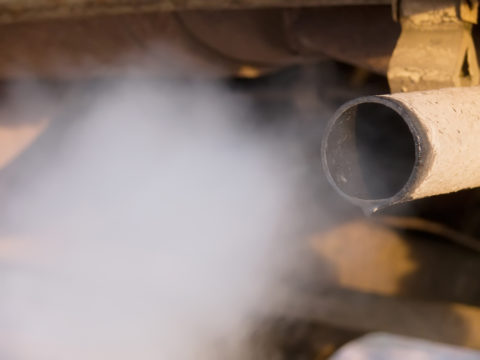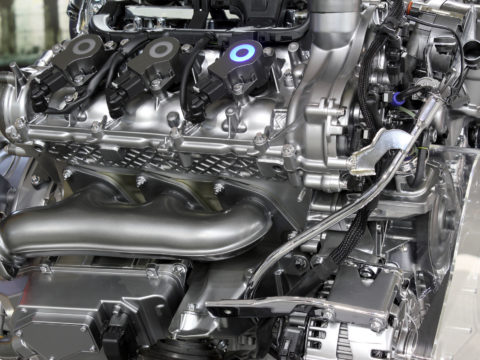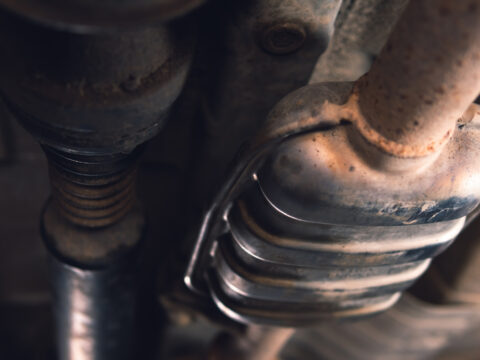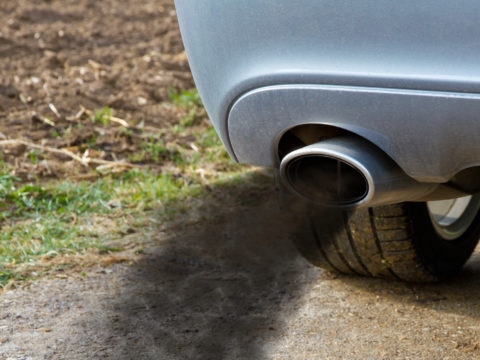Catalytic converters assist in controlling vehicle emissions that enter the environment while driving. This part is now required on all vehicles, but it can get costly to replace. Follow along with this guide to find out what may work to fix a catalytic converter without replacing it.
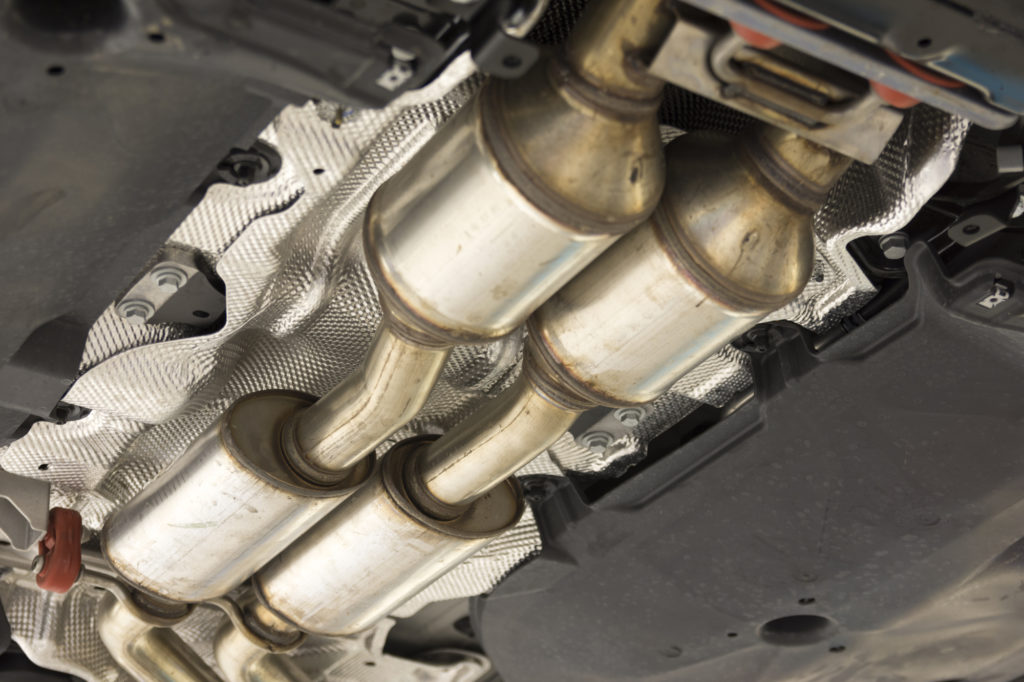
Contents
How Catalytic Converters Work
Catalytic converters use a metal catalyst to cause a chemical reaction that reduces vehicle emissions. Rhodium is a common catalyst used in catalytic converters, but some use platinum, palladium, or gold mixed with another catalytic substance.
The converter first moves toxic gases through the reduction process, during which nitrogen oxide gas turns into separated and less-harmful nitrogen and oxygen gases. Then, the converter uses oxidation to turn carbon monoxide into carbon dioxide by adding oxygen to it. Carbon dioxide already floats harmlessly in the atmosphere.
Importance of a Catalytic Converter
A catalytic converter turns harmful gases into non-toxic ones already found in the environment to reduce pollution. Without it, carbon monoxide and nitrogen oxides would release into the atmosphere at harmful levels, contributing to ozone depletion.
While auto manufacturers must install catalytic converters on all newly made vehicles, some states have more stringent requirements to align with their environmental regulations.
California, Colorado, Maine, and New York require California Air Resources Board (CARB) compliant catalytic converters in vehicles operated within their states. Maine and New York specify model years, but Colorado and California require all vehicles to have CARB-compliant catalytic converters to reduce emissions.
How Catalytic Converters Go Bad
Several problems with your vehicle or the way you drive your vehicle can lead to problems or failures with a catalytic converter. Here are a few common contributors:
1) Fuel in the Exhaust System
One of the most common factors leading to catalytic converter failure is fuel getting into the exhaust system. Vehicles require an exact mixture of fuel and air to run properly. If this ratio is off, unburned fuel can enter the exhaust system, making its way to the catalytic converter.
When this happens, the catalytic converter can overheat. While a short overheating process may not damage the catalytic converter, a long drive with the issue or frequent overheating can cause it to fail relatively quickly.
2) Other Fluids Entering the Exhaust System
Your car uses several different fluids to run, including oil, brake fluid, and transmission fluid. While these fluids are designed to travel specific paths to get where your vehicle needs them, they may end up in the wrong place, like the catalytic converter.
Most commonly, oil and antifreeze are the culprits. Damaged gaskets that typically hold these fluids in place can cause leaks into the exhaust. These fluids can cause buildup in the catalytic converter that blocks ample airflow, ultimately resulting in damage or failure.
3) Not Driving Enough
A catalytic converter relies on getting hot enough to burn off all the deposits it has within its walls from regular exhaust processes. While driving short distances most of the time certainly keeps your gas bill and mileage down, it doesn’t help extend the life of this crucial vehicle part.
Driving longer than 15 minutes at least a few times a week allows your catalytic converter to reach the temperature it needs to burn off anything left inside, keeping it clean and healthy for future trips.
4) Road Damage
Hitting bumps, potholes, and other road hazards can damage your car in many ways, but the underbelly area of your car is the most vulnerable. That’s where the catalytic converter resides, so it’s possible that damaged roads could be the cause of its failure.
Avoid off-roading with vehicles that aren’t equipped to do so, and use care when driving on regular roads. Even a slight fracture in a part of the catalytic converter can cause widespread damage to the part over time.
5) Failing to Get Regular Tune-Ups
The best thing you can do for your vehicle and the catalytic converter is to get engine tune-ups as frequently as your vehicle’s manufacturer recommends. Depending on the age of your car, you may need a tune-up every 10,000 miles.
Tune-ups check spark plugs, wires, and other components that affect the engine, subsequently affecting the catalytic converter. Catching any potential issues early can prevent bigger problems later.
Steps to Fix a Catalytic Converter Without Replacing It
Learning how to fix a catalytic converter without replacing it can help you in the future if you have a minor problem with the part. Your fix may be able to extend the life of the catalytic converter for several weeks or months to give you more time to prepare for a replacement.
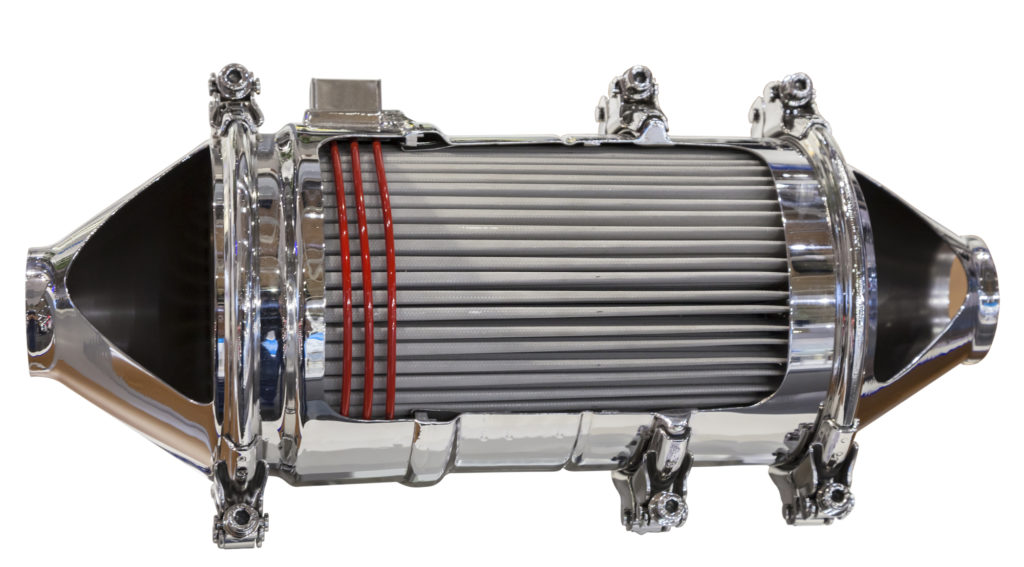
Tools and Equipment Needed
Gathering a few tools and other necessities can prepare you to work on your catalytic converter. First, consider getting another person to help you, as they can provide an extra set of hands when working on your vehicle.
You won’t need anything other than your vehicle and a trusted mechanic or yourself for steps one through four if you know how to fix exhaust and muffler problems. You’ll need a cleaning agent for a catalytic converter for step five. Finally, step six requires a jack, a set of sockets, and a hose or pressure washer.
Step 1: Fix Exhaust Problems
Before learning how to fix a catalytic converter without replacing it, you should eliminate some other potential issues that could be causing problems for your converter. First is the exhaust system.
Exhaust leaks are a common contributor to catalytic converter issues. Inspect your exhaust system for worn gaskets, exhaust leaks, and corroded pipes if you know how to. You might also notice symptoms of an exhaust problem, like decreased fuel efficiency and a burning smell from the engine bay.
Take care of any exhaust issues first and test drive the vehicle several times to see if the symptoms you were experiencing stopped. You might have just saved yourself the hassle of working on your catalytic converter.
Step 2: Check the Muffler
Next, you should rule out any problems with the muffler. Mufflers reduce the noise of your car’s engine, so if there’s a problem with yours, you’ll notice louder noises when your car runs. When a muffler becomes clogged, it can actually cause a lot of similar problems that a failing catalytic converter would.
First, look for physical signs of problems, like holes in the muffler or major rust spots. Bad mufflers may also leak water, so look for lots of dripping or puddles on the ground near your muffler. Finally, if your vehicle has been overheating after running for a short time, your muffler could be the culprit.
Replace worn-out mufflers before fixing your catalytic converter.
Step 3: Take a Long Drive
After ruling out exhaust and muffler issues, it’s time to move onto the catalytic converter.
Catalytic converters work best when you run your vehicle regularly, especially for at least a couple of longer trips each week. This gives them time to heat up enough to burn out all the substances inside them.
Your catalytic converter could simply need some time out on the road to get everything moving and remove buildup within its walls. Take it out for a 30-minute or longer drive, preferably on the highway, to avoid frequent stops and starts, giving it plenty of time to go through its full process.
Step 4: Try Ramping Up the RPMs
If you still experience symptoms of a failing catalytic converter, try running your vehicle a little harder than usual. Boosting the RPMs could be all it needs to warm to a high enough temperature to remove corrosion and buildup.
Step 5: Add a Cleaning Additive
Unfortunately, larger catalytic converter clogs usually need more help than a long drive or higher RPMs. The next step to try is adding a cleaning additive designed to remove built-up gunk from the inside of the part.
Refer to your additive’s package for specific instructions for use. Most additives empty directly into the fuel tank and mix with the fuel to work through the catalytic converter.
Step 6: Clean the Catalytic Converter
The final step to fix your catalytic converter is giving it a thorough cleaning. Only do this if you know how to remove and reinstall the part correctly and safely use a jack.
First, jack up the car and remove the converter’s bolts using sockets. Corroded bolts may need some extra force to remove them, and you may need to replace any that are too corroded to use again.
Then, use a pressure washer to eliminate buildup from the outside and inside of the part. If you don’t have a pressure washer, place the converter in a large bucket filled with water and a mild detergent or vinegar solution. Allow it to sit for several hours or overnight.
Then, spray off the catalytic converter with water, and allow it to dry completely before reinstalling.
Should You DIY or Use a Mechanic?
With minor catalytic converter issues, such as buildup or lack of use, you can sometimes benefit from a DIY fix. You’ll save a lot of money giving a quick repair to a catalytic converter over sending it to a repair shop for a replacement.
With that said, many fixes for this part are usually temporary. If your converter has a crack or has so much buildup that it can’t function properly, a replacement is likely the only long-term option.
Replacing your catalytic converter yourself could be feasible if you know how to find the right one for your vehicle and have intermediate knowledge of how vehicles work and what each part is.
However, some bolts that hold in the converter become so corroded over time that you may need the assistance of a mechanic to remove them. Also, you could end up damaging other parts while trying to replace the catalytic converter, which becomes even costlier in the long run.
If you’re not 100% confident that you can tackle the repair successfully, consider taking your car to a trusted mechanic instead.
Catalytic Converter FAQs
Below, find answers to some of the most common questions about catalytic converters, their cost, and theft.
Can you drive a car without a catalytic converter?
A car will technically operate without a catalytic converter installed. The vehicle will still run just fine, as the part does not affect its ability to operate.
However, removing the catalytic converter is illegal in any part of the United States. Additionally, if you live in an area with required emissions checks, you’ll need a working catalytic converter to pass your car as a legal-to-drive vehicle.
How much is a catalytic converter worth?
The value of a catalytic converter varies depending on a vehicle’s make and model. However, JD Power lists the average cost of one of these parts as $800-$1,200. Having a mechanic install one for you creates additional labor costs.
The reason for the high price tag is that the catalysts used in a catalytic converter are rare and expensive metals. Although catalytic converters typically use as few metals as possible, the little amount they need drives up the price.
Why do people steal catalytic converters?
People steal catalytic converters to avoid paying for a new one plus installation labor from a professional mechanic. Depending on the vehicle and area costs, it’s not uncommon to pay $1,000 to $2,000 or more for a catalytic converter replacement.
Also, catalytic converters are not very challenging to remove from a vehicle. Thieves can use a saw to cut the converter from the car’s underside in a few minutes without the vehicle’s owner knowing until they drive the vehicle.
Is catalytic converter theft covered by insurance?
Comprehensive auto insurance covers incidents other than vehicle collisions, including theft. If your policy includes comprehensive insurance, it typically covers catalytic converter theft.
Still, the way each insurance provider handles these incidents varies, so it’s a good idea to reach out to the company to learn what steps to take if theft occurs.
How do you tell if a catalytic converter is missing?
It’s impossible to tell if a catalytic converter is missing unless you specifically look under your vehicle and know what to look for. However, you’ll notice a loud sound coming from your vehicle, especially when you accelerate. Some cars may also trigger the ‘Check Engine’ light when missing a catalytic converter.
Sources:
https://www.jdpower.com/cars/shopping-guides/what-cars-have-the-most-expensive-catalytic-converters
https://www.walkerexhaust.com/support/tech-tips/state-catalytic-converter-guide.html
https://sliplo.shop/blogs/blog/6-signs-of-a-stolen-catalytic-converter
https://resource-center.meineke.com/when-do-i-need-to-replace-my-muffler/

